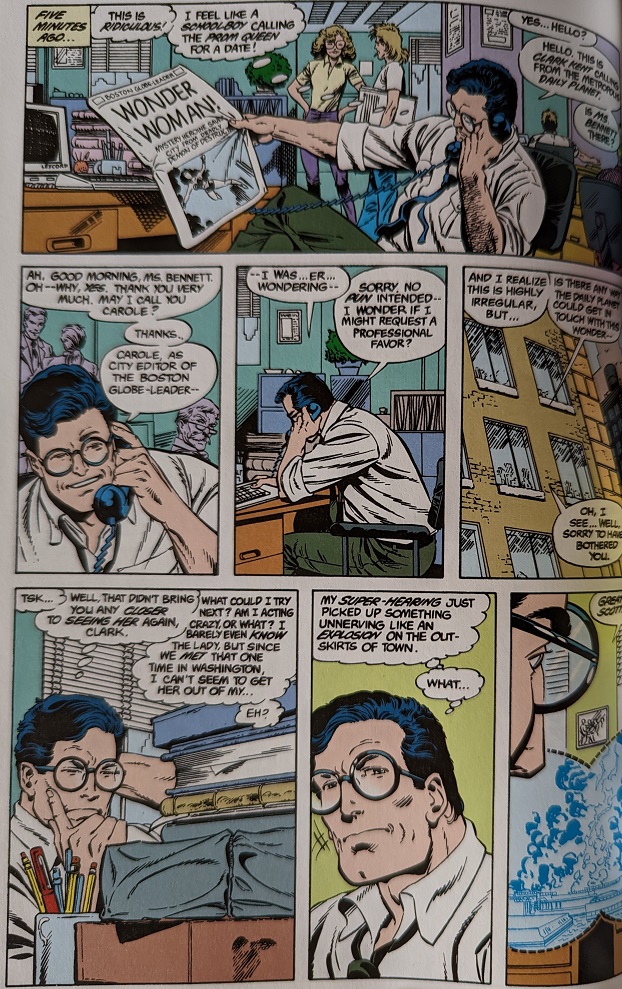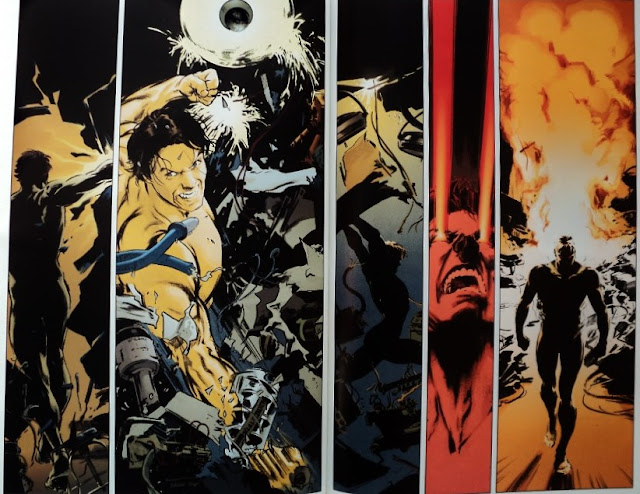After Byrne’s considerable contributions to DC in the mid 80s, he would return to Marvel Comics to write and draw She-Hulk, a character that he had also included in his run on Fantastic Four in the early 80s. It’s evident that Byrne always had an admiration for She-Hulk but of course that didn’t stop when he was working for DC Comics. That’s why in “Rampage!” (originally published in Superman # 7, July 1987), he created DC’s version of She-Hulk.
The story begins with Lois Lane visiting a highly advanced lab in which Dr. Kitty Faulkner and Thomas Moyers, two scientists, are trying to create a new source of energy. Of course, as it so often happens in comic books (and I guess in real life too), the scientists are dealing with forces they don’t fully understand, and with quite lethal outcomes. As one might expect, an accident occurs and the reactor blows up, releasing this new experimental energy which latches onto the nearest body and transforms it into a raging being of unstoppable strength.
In the initial confrontation, Moyers tells Superman that this orange She-Hulk, quickly baptized my Metropolis media as Rampage, is in fact Lois Lane, who happened to be closer to the reactor. However, it’ll be later revealed that Kitty Faulkner pushed Lois Lane out of harm’s way and took the full brunt of the explosion (much in the same way Bruce Banner does to save Rick Jones in the first ever Hulk comic). When Superman thinks he’s fighting against Lois Lane, he’s deeply concerned, and can’t even think about a way to revert her to her normal self. The battle sequences are vibrant and dynamic, proving once again that Byrne is the perfect artist for superhero comics.
 |
| Lois Lane, Kitty Faulkner & Thomas Moyers |
Fortunately, as the battle goes on, Superman discovers that Rampage obtains her powers thanks to solar energy, and since Superman’s Kryptonian cells act as living batteries absorbing energy from our yellow sun, he decides to absorb Rampage’s energy, thus reverting her to her human form, id est, Kitty Faulkner. She will appear in subsequent years and even become a somewhat recurring character in Peter David’s Supergirl, while Moyers also has a reappearance in an annual written by Byrne.
 |
| Clark Kent |
One of my favorite moments takes place before the appearance of Rampage, when Clark Kent uses his connection to the Daily Planet to get in touch with the Boston Globe, his purpose: to send a message to Wonder Woman, the heroine that has conquered him with her beauty. In fact, as we saw in “The Mummy Strikes”, Superman had a rather intense erotic dream involving Wonder Woman, and now he’s obsessed with seeing her again.
________________________________________________________________________________________________________
________________________________________________________________________________________________________
Después de las considerables contribuciones de Byrne a DC a mediados de los 80s, regresaría a Marvel Comics para escribir y dibujar a She-Hulk, un personaje que también había incluido en su etapa en Fantastic Four a principios de los 80s. Es evidente que Byrne siempre tuvo admiración por She-Hulk pero, por supuesto, esto continuó cuando trabajaba para DC Comics. Es por eso que en “Rampage” (publicado originalmente en Superman # 7, julio de 1987), creó la versión de DC de She-Hulk.
 |
| Rampage |
La historia comienza con la visita de Lois Lane a un laboratorio muy avanzado en el que la Dra. Kitty Faulkner y Thomas Moyers, dos científicos, intentan crear una nueva fuente de energía. Por supuesto, como sucede con tanta frecuencia en los cómics (y suponemos que también en la vida real), los científicos se enfrentan a fuerzas que no comprenden del todo y con resultados bastante mortales. Como era de esperar, ocurre un accidente y el reactor explota, liberando esta nueva energía experimental que se adhiere al cuerpo más cercano y lo transforma en un ser furioso de fuerza imparable.
En el enfrentamiento inicial, Moyers le dice a Superman que esta She-Hulk anaranjada, rápidamente bautizada en la prensa de Metropolis como Rampage, es en realidad Lois Lane, quien resultó estar más cerca del reactor. Sin embargo, más tarde se revelará que Kitty Faulkner empujó a Lois Lane fuera de peligro y recibió todo el impacto de la explosión (de la misma manera que lo hace Bruce Banner para salvar a Rick Jones en el primer cómic de Hulk). Cuando Superman cree que está luchando contra Lois Lane, está profundamente preocupado y ni siquiera puede pensar en una forma de hacer que ella vuelva a su estado normal. Las secuencias de batalla son vibrantes y dinámicas, lo que demuestra una vez más que Byrne es el artista perfecto para los cómics de superhéroes.
 |
| Rampage versus Superman |
Afortunadamente, a medida que avanza la batalla, Superman descubre que Rampage obtiene sus poderes gracias a la energía solar, y dado que las células kriptonianas de Superman actúan como baterías vivientes que absorben energía de nuestro sol amarillo, decide absorber la energía de Rampage, revirtiéndola así a su forma humana, es decir, Kitty Faulkner. Ella aparecerá en los años siguientes e incluso se convertirá en un personaje algo recurrente en Supergirl de Peter David, mientras que Moyers también tiene una reaparición en un anual escrito por Byrne.
 |
| Superman vs Rampage |
Uno de mis momentos favoritos tiene lugar antes de la aparición de Rampage, cuando Clark Kent utiliza su conexión con el Daily Planet para ponerse en contacto con el Boston Globe, su propósito: enviarle un mensaje a Wonder Woman, la heroína que lo ha conquistado con su belleza. De hecho, como vimos en “The Mummy Strikes”, Superman tuvo un sueño erótico bastante intenso con Wonder Woman, y ahora está obsesionado con volver a verla.






























